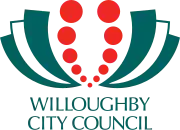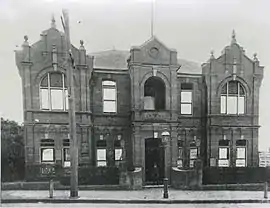City of Willoughby
The City of Willoughby is a local government area on the Lower North Shore of Northern Sydney, in the state of New South Wales, Australia.[3] It is located 6 kilometres (3.7 mi) north of the Sydney central business district. It was first proclaimed in October 1865 as the Municipality of North Willoughby.
| City of Willoughby New South Wales | |||||||||||||||
|---|---|---|---|---|---|---|---|---|---|---|---|---|---|---|---|
 Location in Metropolitan Sydney | |||||||||||||||
| Coordinates | 33°48′S 151°11′E | ||||||||||||||
| Population |
| ||||||||||||||
| • Density | 3,288/km2 (8,515/sq mi) | ||||||||||||||
| Established | 23 October 1865 | ||||||||||||||
| Area | 22.6 km2 (8.7 sq mi) | ||||||||||||||
| Mayor | Gail Giles-Gidney | ||||||||||||||
| Council seat | Chatswood | ||||||||||||||
| Region | Metropolitan Sydney | ||||||||||||||
| State electorate(s) | |||||||||||||||
| Federal Division(s) | |||||||||||||||
 | |||||||||||||||
| Website | City of Willoughby | ||||||||||||||
| |||||||||||||||
The main commercial centre of the City of Willoughby is Chatswood, home to one of Sydney's suburban skyscraper clusters. Other commercial centres are the suburbs of Willoughby, St Leonards and Artarmon. Willoughby is situated on an elevated plateau, and all of Sydney's television stations broadcast from towers in the area. Within the City of Willoughby is the Royal North Shore Hospital, located at St Leonards, one of Sydney's major hospitals.
Suburbs in the local government area
Suburbs and Localities in the City of Willoughby are:
- Artarmon
- Artarmon Industrial Area
- Castle Cove
- Castlecrag
- Chatswood
- Chatswood West (shared with City of Ryde)
- East Willoughby
- Gore Hill (shared with Municipality of Lane Cove)
- Middle Cove
- Lane Cove North (shared with Municipality of Lane Cove)
- Naremburn
- North Willoughby
- Northbridge
- Roseville (shared with Ku-ring-gai Council)
- St Leonards (shared with Municipality of Lane Cove and North Sydney Council)
- Willoughby
Heritage listings
The City of Willoughby has a number of heritage-listed sites, including:
- Artarmon, 559 Pacific Highway: Chatswood Reservoirs No. 1 and No. 2[4]
- Castle Cove, 14 Cherry Place: Innisfallen Castle and grounds[5]
- Castlecrag, 375 Edinburgh Road: Buhrich House II[6]
- Castlecrag, 8 The Barbette: Duncan House (Castlecrag)[7]
- Castlecrag, 80 The Bulwark: The Glass House (Castlecrag)[8]
- Castlecrag, 15 The Citadel: Fishwick House[9]
- Chatswood, 258-260 Mowbray Road: Windsor Gardens (Chatswood)[10]
- Chatswood, 313-315 Mowbray Road: Hilton (Chatswood)[11]
- Gore Hill, Pacific Highway: Gore Hill Memorial Cemetery[12]
- Willoughby, 85-87 Penshurst Street: Laurelbank[13]
- Willoughby, 2 Small Street: Walter Burley Griffin Incinerator, Willoughby[14]
Demographics
At the 2016 Census, there were 74,302 people in the Willoughby local government area, of these 48.0% were male and 52.0% were female. Aboriginal and Torres Strait Islander people made up 0.2% of the population. The median age of people in the City of Willoughby was 37 years. Children aged 0 – 14 years made up 19.4% of the population and people aged 65 years and over made up 13.6% of the population. Of people in the area aged 15 years and over, 54.6% were married and 8.2% were either divorced or separated.[1]
Population growth in the City of Willoughby between the 2006 Census and the 2011 Census was 5.9%; and in the subsequent five years to the 2016 Census, population growth was 10.3%. When compared with total population growth of Australia for the same periods, being 8.3% and 8.8% respectively, population growth in Willoughby local government area has accelerated faster than the national average.[15]
At the 2016 Census, the proportion of residents in Willoughby local government area who stated their ancestry as Chinese was in excess of four times the state and national averages; and the proportion of households where an Asian language was spoken at home was approximately five times higher than the national average.[1]

| Selected historical census data for Willoughby local government area | ||||||
|---|---|---|---|---|---|---|
| Census year | 2001[16] | 2006[15] | 2011[17] | 2016[1] | ||
| Population | Estimated residents on census night | 58,319 | 63,605 | 67,356 | 74,302 | |
| LGA rank in terms of size within New South Wales | 19th | 33rd | 32nd | |||
| % of New South Wales population | 0.97% | 0.99% | ||||
| % of Australian population | 0.31% | 0.32% | 0.31% | 0.32% | ||
| Cultural and language diversity | ||||||
| Ancestry, top responses | English | 20.5% | ||||
| Chinese | 14.5% | |||||
| Australian | 18.3% | |||||
| Irish | 7.4% | |||||
| Scottish | 5.6% | |||||
| Language, top responses (other than English) | Mandarin | 3.6% | ||||
| Cantonese | 6.7% | |||||
| Korean | 1.7% | |||||
| Japanese | 2.4% | |||||
| Armenian | n/c | |||||
| Religious affiliation | ||||||
| Religious affiliation, top responses | No religion | 18.6% | ||||
| Catholic | 26.1% | |||||
| Anglican | 19.5% | |||||
| Buddhism | 3.7% | |||||
| Not Stated | 8.7% | |||||
| Median weekly incomes | ||||||
| Personal income | Median weekly personal income | A$728 | A$858 | A$946 | ||
| % of Australian median income | 156.2% | 148.7% | 142.9% | |||
| Family income | Median weekly family income | A$1,667 | A$2,479 | A$2,671 | ||
| % of Australian median income | 162.3% | 167.4% | 154.0% | |||
| Household income | Median weekly household income | A$2,066 | A$1,996 | A$2,271 | ||
| % of Australian median income | 176.4% | 161.8% | 157.9% | |||
Council
Current composition and election method
Willoughby City Council is composed of thirteen councillors, including the mayor, for a fixed four-year term of office. The Mayor is directly elected while the twelve other councillors are elected proportionally as four separate wards, each electing three councillors. The most recent Council election was held on 9 September 2017.

| Party | Councillors | |
|---|---|---|
| Independents | 12 | |
| The Greens | 1 | |
| Total | 13 | |
The current Council is:
| Ward | Councillor | Party | Notes | |
|---|---|---|---|---|
| Mayor[18] | Gail Giles-Gidney | Independent | Elected Mayor April 2014, re-elected September 2017, Deputy Mayor September 2013 – January 2014 | |
| Middle Harbour[19] | Wendy Norton | Independent | Deputy Mayor 2010-2012 | |
| Judith Rutherford | Independent | Deputy Mayor 1997-1999 September 2018 - Present | ||
| Angelo Rozos | Independent | |||
| Naremburn[20] | Stuart Coppock | Independent | Deputy Mayor 2012 – 2013, April 2014 - September 2014. September 2016 - September 2017 | |
| Christine Tuon | Independent | |||
| Nic Wright | Independent | |||
| Sailors Bay[21] | Hugh Eriksson | Independent | Deputy Mayor September 2017 - September 2018 | |
| Denis Fernandez | Independent | |||
| Brendon Zhu | Independent | |||
| West[22] | Tony Mustaca | Independent | Deputy Mayor September 2014 – September 2015 | |
| Craig Campbell | Independent | |||
| Lynne Saville | Greens | |||
History

In May 1865, 67 residents of the rural District of Willoughby sent a petition to the Governor Sir John Young, requesting the incorporation of the Municipality of North Willoughby.[23] This resulted in the Municipality of North Willoughby being formally proclaimed on 23 October 1865.[24] The council first met to elect six Councillors and two Auditors on 16 December 1865, in the house of James Harris French and the first Chairman, James William Bligh, was elected on 1 January 1866.
There were no wards until 1876 when the council was divided into three wards: Chatsworth Ward to the north, Middle Harbour Ward to the east and Lane Cove Ward to the west. Lane Cove Ward became the separate Municipality of Lane Cove on 11 February 1895 and Middle Harbour Ward was divided into Middle Harbour and Naremburn wards.[25] With the passing of the Municipalities Act, 1867, the name was changed to be the Borough of North Willoughby, which then changed to Borough of Willoughby in the Borough of Willoughby Naming Act 1890.[26] In June 1900, a petition to expand the number of wards from three to four, each electing three aldermen, was proclaimed dividing Chatsworth Ward into Chatswood East and West wards in addition to Middle Harbour and Naremburn wards.[27] From 28 December 1906, with the passing of the Local Government Act, 1906, the council area was renamed the Municipality of Willoughby. In August 1941, the Minister for Local Government, James McGirr, approved a proposal to split Middle Harbour Ward, adding Northbridge Ward as the fifth ward electing three aldermen.[28]
The first council meetings were held in a hut located behind the main residence of major landholder and timer merchant, James Harris French, on the corner of Penshurst and Penkivil Streets. Municipal offices were afterwards established in Penshurst Street near Forsyth Street corner. These were in turn followed by the Council Chambers in the old School of Arts building in Mowbray Road from 1877, which then became part of the Mowbray House School. These chambers were replaced in 1903 by the first Town Hall building in Victoria Avenue, designed by Byera Hadley and officially opened by the Premier, Sir John See, on 2 September 1903.[29][30] The first town hall was demolished in 1969 and replaced by the second Willoughby Town Hall with the adjacent Council Administration Centre as the "Willoughby Civic Centre".[31] The council was granted city status and was proclaimed as the City of Willoughby on 17 November 1989.
A 2015 review of local government boundaries by the NSW Government Independent Pricing and Regulatory Tribunal recommended that the City of Willoughby merge with adjoining councils. The government considered two proposals. The first proposed a merger of the North Sydney and Willoughby Councils to form a new council with an area of 33 square kilometres (13 sq mi) and support a population of approximately 145,000.[32] The alternative, proposed by Warringah Council on 23 February 2016, was for an amalgamation of the Pittwater, Manly and Warringah councils. As a consequence of Warringah's proposal, the New South Wales Minister for Local Government Paul Toole proposed that the North Sydney, Willoughby and Mosman Councils merge.[33] In July 2017, the Berejiklian government decided to abandon the forced merger of the North Sydney, Willoughby and Mosman local government areas, along with several other proposed forced mergers.[34]
Council seal
The Council seal first appeared in records on 7 May 1867, containing only the words "Municipality of North Willoughby Common Seal". In 1890 the floral emblem was used in the middle of the seal for the first time with "Borough of Willoughby". Willoughby became a City on 17 November 1989 and the city crest was altered accordingly, with the wording "The Council of the City of Willoughby" replacing the previous title and a mural crown added to symbolise city status. It was this latest seal that was incorporated into the Willoughby City Flag, designed by John Vaughan and first flown on 12 May 1990.[35]
The present council seal, formally adopted in August 1990, contains an emblem of various native flowers:[35]
- Waratah - Telopea speciosissima
- Christmas Bell - Blandfordia grandiflora
- Sydney Red Gum - Angophora costata
- Flannel Flower - Actinotus helianthi
- Native Rose - Boronia serrulata
Two of the main pioneering industries of the area are also symolised in the seal: the tanning industry represented by the leather belt and the brick-making industry represented in the mural crown. In July 1999, council adopted a corporate logo, taking the form of a stylised Waratah, with the phrase "City of Diversity".[22]
References
- Australian Bureau of Statistics (27 June 2017). "Willoughby (C)". 2016 Census QuickStats. Retrieved 9 January 2018.

- "3218.0 – Regional Population Growth, Australia, 2017-18". Australian Bureau of Statistics. 27 March 2019. Retrieved 27 March 2019. Estimated resident population (ERP) at 30 June 2018.
- http://www.pastvtr.elections.nsw.gov.au/LGE2012/willoughby-city-council.html?type=sailors-bay-ward
- "Chatswood Reservoirs No. 1 and No. 2". New South Wales State Heritage Register. Office of Environment and Heritage. H01321. Retrieved 18 May 2018.
- "Innisfallen Castle and Grounds". New South Wales State Heritage Register. Office of Environment and Heritage. H00404. Retrieved 18 May 2018.
- "Buhrich House II". New South Wales State Heritage Register. Office of Environment and Heritage. H01513. Retrieved 18 May 2018.
- "Duncan House". New South Wales State Heritage Register. Office of Environment and Heritage. H00742. Retrieved 18 May 2018.
- "The Glass House". New South Wales State Heritage Register. Office of Environment and Heritage. H01981. Retrieved 18 May 2018.
- "Fishwick House, The". New South Wales State Heritage Register. Office of Environment and Heritage. H01751. Retrieved 18 May 2018.
- "Windsor Gardens". New South Wales State Heritage Register. Office of Environment and Heritage. H00571. Retrieved 18 May 2018.
- "Hilton". New South Wales State Heritage Register. Office of Environment and Heritage. H00374. Retrieved 18 May 2018.
- "Gore Hill Memorial Cemetery". New South Wales State Heritage Register. Office of Environment and Heritage. H01491. Retrieved 18 May 2018.
- "Laurelbank". New South Wales State Heritage Register. Office of Environment and Heritage. H00657. Retrieved 18 May 2018.
- "Walter Burley Griffin Incinerator". New South Wales State Heritage Register. Office of Environment and Heritage. H00084. Retrieved 18 May 2018.
- Australian Bureau of Statistics (25 October 2007). "Willoughby (C)". 2006 Census QuickStats. Retrieved 8 November 2012.
- Australian Bureau of Statistics (9 March 2006). "Willoughby (C)". 2001 Census QuickStats. Retrieved 8 November 2012.
- Australian Bureau of Statistics (31 October 2012). "Willoughby (C)". 2011 Census QuickStats. Retrieved 8 November 2012.

- "Willoughby City Council – Mayoral Election". Local Government Elections 2012. Electoral Commission of New South Wales. 13 September 2012. Archived from the original on 28 November 2012. Retrieved 21 September 2012.
- "Willoughby City Council – Middle Harbour Ward". Local Government Elections 2012. Electoral Commission of New South Wales. 17 September 2012. Archived from the original on 29 November 2012. Retrieved 21 September 2012.
- "Willoughby City Council – Naremburn Ward". Local Government Elections 2012. Electoral Commission of New South Wales. 17 September 2012. Archived from the original on 27 November 2012. Retrieved 21 September 2012.
- "Willoughby City Council – Sailors Bay Ward". Local Government Elections 2012. Electoral Commission of New South Wales. 17 September 2012. Archived from the original on 27 November 2012. Retrieved 21 September 2012.
- "Willoughby City Council – West Ward". Local Government Elections 2012. Electoral Commission of New South Wales. 17 September 2012. Archived from the original on 27 November 2012. Retrieved 21 September 2012.
- "PETITION UNDER THE MUNICIPAL ACT". New South Wales Government Gazette (107). New South Wales, Australia. 30 May 1865. p. 1161. Retrieved 20 June 2016 – via National Library of Australia.
- "MUNICIPALITY OF NORTH WILLOUGHBY". New South Wales Government Gazette (227). New South Wales, Australia. 25 October 1865. p. 2401. Retrieved 20 June 2016 – via National Library of Australia.
- "Government Gazette Proclamations and Legislation". New South Wales Government Gazette (101). New South Wales, Australia. 11 February 1895. p. 914. Retrieved 20 June 2016 – via National Library of Australia.
- "Borough of Willoughby Naming Act of 1890 No bwn" (PDF). 1890 New South Wales Acts As Made Legislation. Australasian Legal Information Institute. Retrieved 20 June 2016.
- "PROCLAMATION". New South Wales Government Gazette (632). New South Wales, Australia. 26 June 1900. p. 4928. Retrieved 21 June 2016 – via National Library of Australia.
- "FIVE WARDS FOR WILLOUGHBY". The Sydney Morning Herald (32, 324). New South Wales, Australia. 4 August 1941. p. 7. Retrieved 21 June 2016 – via National Library of Australia.
- "WILLOUGHBY'S JUBILEE". Evening News (15, 092). New South Wales, Australia. 23 October 1915. p. 8. Retrieved 20 June 2016 – via National Library of Australia.
- "DEVELOPMENT OF WILLOUGHBY". The Sydney Morning Herald (20, 432). New South Wales, Australia. 3 September 1903. p. 5. Retrieved 20 June 2016 – via National Library of Australia.
- "New Hall for Willoughby". The Sydney Morning Herald. 27 March 1962. Retrieved 21 June 2016.
- "Merger proposal: North Sydney Council, Willoughby City Council" (PDF). Government of New South Wales. January 2016. p. 8. Retrieved 27 February 2016.
- Toole, Paul (25 February 2016). "North Sydney, Willoughby and Mosman councils Proposal" (PDF). Government of New South Wales. Retrieved 27 February 2016.
- Blumer, Clare; Chettle, Nicole (27 July 2017). "NSW council amalgamations: Mayors fight to claw back court dollars after backflip on merger". ABC News. Australia. Retrieved 27 July 2017.
- "Fact Sheet 10 - Council Seal". www.willoughby.nsw.gov.au. Willoughby City Library Service. Retrieved 20 June 2016.